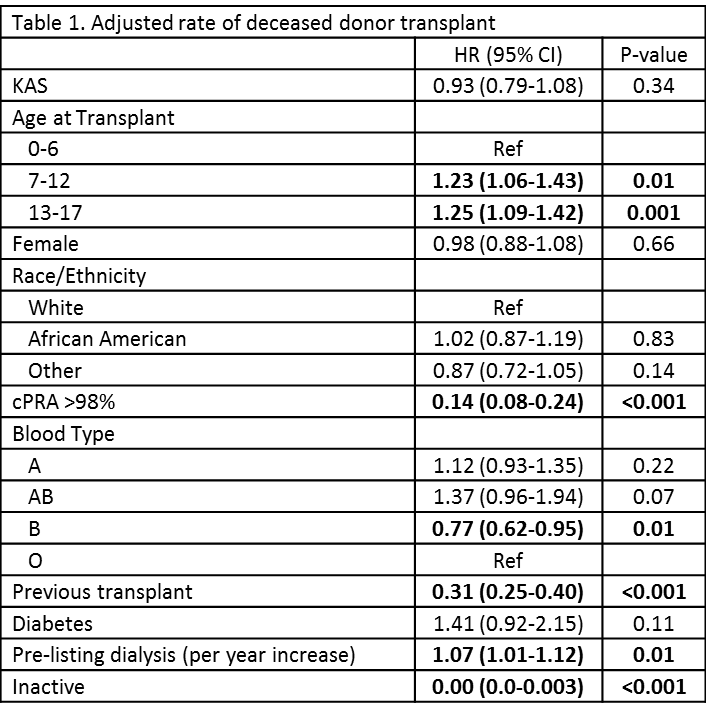Stable Deceased Donor Transplantation Rates Among Pediatric Candidates Post-KAS Implementation.
1University of Alabama at Birmingham, Birmingham
2University of Pennsylvania, Philadelphia
Meeting: 2017 American Transplant Congress
Abstract number: 362
Keywords: Allocation, Kidney transplantation, Waiting lists
Session Information
Session Name: Concurrent Session: Kidney: Pediatric Adherence and Allocation
Session Type: Concurrent Session
Date: Monday, May 1, 2017
Session Time: 4:30pm-6:00pm
 Presentation Time: 5:06pm-5:18pm
Presentation Time: 5:06pm-5:18pm
Location: E353B
Background: The Kidney Allocation System (KAS) was implemented in December 2014 and increased access to deceased donor kidney transplant (DDKT) for highly sensitized candidates. Concerns about access to DDKT for pediatric patients persist. The goal of this study was to explore DDKT rates among pediatric candidates by allocation era.
Methods: 4,093 pediatric kidney listings were identified from SRTR (01/01/2013-03/02/2016). Time-at-risk began at date of listing, and candidates were followed until the earliest of death, transplant, or end of study. Candidates listed pre-KAS contributed time at-risk to the pre-KAS group until implementation, after which they contributed post-KAS time-at-risk. Candidate and transplant recipients were compared across allocation era. Cox proportional hazards model was used to estimate DDKT rate and was adjusted for age, gender, race, cPRA, blood type, previous transplant, diabetes, status on the waitlist, and pre-listing dialysis duration. First-degree interaction terms were used to assess for effect modification by allocation era.
Results: Highly sensitized patients (cPRA ≥ 98%) were more frequently transplanted post-KAS (2.1% vs. 0.4%, p=0.003), and recipients post-KAS experienced longer time on dialysis pre-transplant than pre-KAS recipients (467 days vs. 290 days, p=0.02). After adjustment KAS was not associated with a significant change in DDKT rate independent of candidate characteristics (aHR: 0.93, 95%CI: 0.79-1.08, p=0.34).  Conclusions: Rate of DDKT among pediatric candidates has not significantly changed following implementation of KAS. Future research assessing the impact of increased pre-transplant dialysis time on long-term outcomes and quality of life among pediatric recipients is needed.
Conclusions: Rate of DDKT among pediatric candidates has not significantly changed following implementation of KAS. Future research assessing the impact of increased pre-transplant dialysis time on long-term outcomes and quality of life among pediatric recipients is needed.
CITATION INFORMATION: Shelton B, Ray C, Sawinski D, Reed R, MacLennan P, Locke J. Stable Deceased Donor Transplantation Rates Among Pediatric Candidates Post-KAS Implementation. Am J Transplant. 2017;17 (suppl 3).
To cite this abstract in AMA style:
Shelton B, Ray C, Sawinski D, Reed R, MacLennan P, Locke J. Stable Deceased Donor Transplantation Rates Among Pediatric Candidates Post-KAS Implementation. [abstract]. Am J Transplant. 2017; 17 (suppl 3). https://atcmeetingabstracts.com/abstract/stable-deceased-donor-transplantation-rates-among-pediatric-candidates-post-kas-implementation/. Accessed December 27, 2025.« Back to 2017 American Transplant Congress
